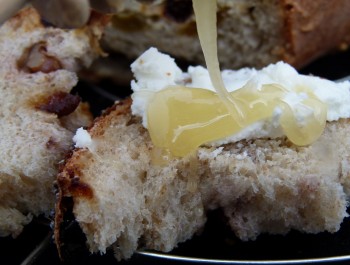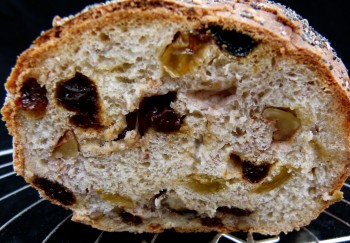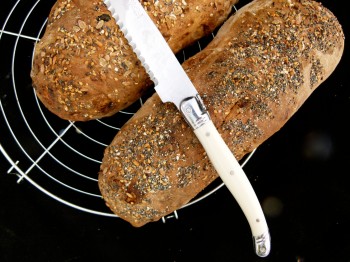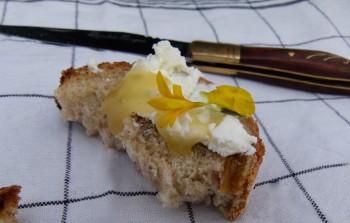raisin and nut bread
makes two 1½ pound loaves
what you need:
¼ ounce instant yeast
2 cups (16 ounces) warm water
1 ounce quality honey
4 ounces King Arthur whole wheat flour
~18 ounces King Arthur bread flour
½ ounce kosher salt
1 cup raisins (all colors)
1 cup walnut pieces, toasted
½ cup whole and halved hazelnuts, blanched and toasted
mix of flaxseeds, poppy seeds, sunflower seeds (as needed)
how to:
mix
- Activate Yeast. Warm the water (between 90-100 degrees Fahrenheit). Dissolve the yeast in the water (either let it sit until it is foamy or help it along with your hands or a bowl scraper).
- Feed Yeast. Using a bowl scraper (or your hands), add the honey to the yeast and mix until dissolved.
- Add Whole Wheat Flour. Add the whole wheat flour and mix.
- Add Salt And Bread Flour. Add the salt. Begin adding the bread flour by the cup full (note that your cooking environment will influence how much flour you add. For example, if the weather is dry, you may use a little less flour. In contrast, if it is humid, you may use a little more flour). Add the raisins and the nuts at the same time you are incrementally adding the bread flour. Use the bowl scraper to incorporate the ingredients. Once the dough has come together (taken shape) remove from the mixing bowl and place on a surface lightly covered with bread flour.
- Rest And Knead. Let the dough rest for a couple of minutes before you begin kneading it. Dust your hands with bread flour and begin to knead the dough by pressing the palm of your hand into the dough, rotating the dough, and then press down with your palm again. You are finished kneading the dough when it is a smooth ball with no cracks, and slightly sticky. Dough should not feel dry.
bulk fermentation
- Let It Rise (For The First Time). Rub (or spray) olive oil on the inside of a large stainless bowl. Place the dough in the bowl and rub a tad of olive oil on top of the bread. Loosely cover the dough with plastic wrap or a clean dishtowel. Let dough sit for approximately 3 hours at room temperature until dough doubles in size (you can draw a circle on the plastic wrap to indicate how big the dough was when it began).
punch it out/benching/panning and shaping
- Punch Out The Gas. Remove dough from the bowl and gently knead it (called “punching it”) to eliminate gas bubbles from the dough.
- Scale/Portion. Use a bowl or bench scraper to cut the dough in half. Weigh the two halves with a kitchen scale…each one should weigh 1 ½ pounds.
- Rounding. Use both hands to cup the dough and shape it in a ball. Rub it on the table in a slightly clockwise motion to creating a tighter shape for the dough (this will trap air and give the outside a nice crust).
- Bench It. Let the loaves rest for a few minutes (give gluten a chance to rest) before shaping it.
proofing (let rise a second time)
- The Second Rise. Lightly spray the bottom of the dough with nonstick spray or rub with a touch of olive oil and place on a baking sheet lined with parchment paper. Place a clean dish towel (or use plastic wrap) gently over the loaves. Let the loaves rise a second time to get it to its baking shape. Use the “ thumb test” to determine if the dough is done proofing: It is done if the outside feels a little soft (the consistency should feel like a marshmallow) and when you poke your thumb into it, the dough returns slowly. If it springs back quickly, it needs more time. If it does not spring back, it went too far. Punch it out and reshape again.
- Garnish. Lightly brush the loaves with water. Generously garnish with a combination of seeds.
bake
- Bake. In an oven preheated to 400 degrees Fahrenheit (or 375 degrees Fahrenheit convection), place the loaves on a baking stone (or use a baking sheet) on the middle rack. Place ice cubes in a small ovenproof dish and place the dish on the bottom of the oven (be careful not to drop ice on glass oven door). Bake until the crust is a deep golden brown and has an internal temperature of 200-205 degrees. You will be able to smell it (do not open the door early). If you want to char the crust, move the bread at the end of the baking stage to a higher rack.
- Cool. If you can resist, try, let the bread cool completely on a wire rack before cutting it open.
Tags: Gale, hazelnuts, Hunger Games, Hunger Games Food, Hunger Games Recipes, raisin bread, walnut











Leave a Reply